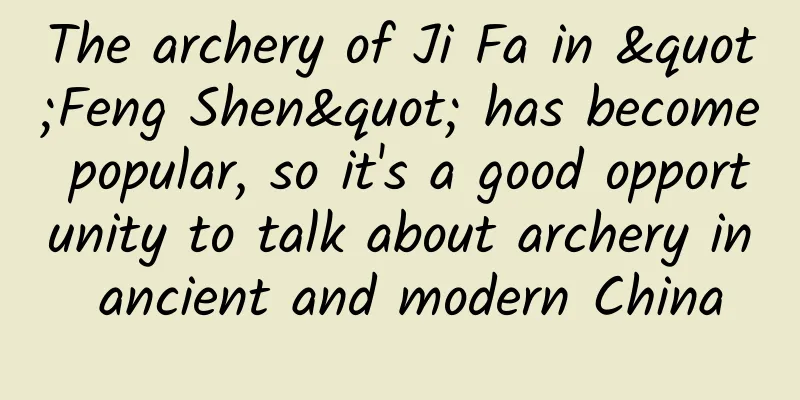The archery of Ji Fa in "Feng Shen" has become popular, so it's a good opportunity to talk about archery in ancient and modern China

|
Recently, the movie "Fengshen" has become a big hit I believe that many viewers are interested in the film Jifa's horse riding and archery on the battlefield left a deep impression This is also the result of the actors' 6-month training. Stills of Ji Fa riding and shooting in "Fengshen", source: Douban Archery, the ancient art Therefore, it has returned to the public eye again In this issue, we will take you to learn more about The Past and Present of Chinese Archery Feel the infinite charm of this technique~ #01Is Chinese shooting really like what is shown in movies and TV dramas? We often see such archery scenes in many movies and TV dramas: the characters in the drama hold the arrow shaft with the index and middle fingers of their right hand, hook the bowstring and pull it back, with the arrow shaft on the left side of the bow. Screenshot of TV series, source: Internet However, ancient Chinese people did not shoot arrows this way. This shooting method is the European shooting method, also known as the "Mediterranean shooting method". In addition, because it takes a lot of strength to draw the bow, the "Mediterranean shooting method" also requires the use of the ring finger to hook the string. Because the prop bows used in filming are very weak, actors generally do not use their ring fingers. At least since the Shang Dynasty, the Chinese have already developed their own unique archery method, which we can call "Chinese archery" and Western scholars call "Mongolian archery." In fact, many ancient Asian ethnic groups used this method, such as the many nomadic peoples on the Mongolian Plateau, as well as the Manchu, Tibetan, Korean and other ethnic groups. This shooting method uses the thumb to hook the string. In order to protect the thumb, the Eastern people invented the thumb ring, also called the thumb ring. There is a small indentation or a small protrusion on it, which is used to hook the string. The top one is the Mediterranean style of shooting; the bottom one is the Chinese style of shooting. Image source: First Cultural Relics Restoration Institute Let's take the most common right-hand bowstring as an example to explain the action of archery. Wear the ring on the thumb of the right hand, hook the bowstring with the small notch or protrusion and pull it back. In order to strengthen the thumb, also press the index finger and middle finger on the thumb. The arrow shaft is on the right side of the bow. After aiming, spread your fingers, release the bowstring, and shoot the arrow. So, why are there two different shooting methods? Because the Chinese bow is an Asian composite bow, that is, a bow made of multiple materials. The main trunk of the composite bow is not made of a single piece of wood or bamboo, but is made of multiple sections of materials stacked together, so that the bow is stronger. Chinese bows and arrows, source: CCTV documentary "Ancient Weapons Revealed - Bows" screenshot Asian composite bows have shorter bodies but are very flexible, and the strings can be stretched very long. European bows are monolithic bows, that is, bows made of a single material, the most typical example being the English longbow, which has a long body and poor flexibility. The English longbow in the movie "Brave Heart", source: movie screenshot When these two bows are fully drawn, the angles of the bowstrings are different. Asian compound bows often form sharp angles, so too many fingers cannot be placed at the string hook, otherwise the fingers will be squeezed. In this way, using a single thumb to hook the string becomes the best option, which eventually forms the "Chinese shooting method." The European single bow has a larger bowstring angle and a looser hook, so it can be hooked and pulled with three fingers, eventually forming the "Mediterranean shooting method". #02The development of Chinese archery According to archaeological evidence from the Zhiyu site in Shuo County, Shanxi Province, traditional Chinese archery has a long history of at least 30,000 years. Archery was once an important tool for hunting, courtship, and warfare, and was also an important part of the ancient Chinese Confucian "Six Arts" education and aristocratic social life. The Western Zhou Dynasty once created a rich and diverse "shooting" activity, and built a complete set of "shooting ceremonies". Ancient scholars have long pointed out that from the "Dasou Ceremony" held by the Western Zhou emperor to the "Xiangshe Ceremony" at the grassroots level of various vassal states, they all have the dual nature of combining military and education in shooting. It is not a single military activity, and its sports nature is obvious and unquestionable. Contemporary historian Mr. Yang Kuan pointed out that the frequently held Xiangshe Ceremony is actually a kind of sports meeting with shooting as the content held by the Chinese people in their hometown. In essence, this is the oldest sports awareness and practice of the Chinese people, and it is a sports meeting that combines competition and education. After the Confucianists of the pre-Qin period included archery in the "Six Arts" and formed a four-level "archery ceremony" system of "Grand Archery Ceremony", "Bin Archery Ceremony", "Yan Archery Ceremony" and "Xiang Archery Ceremony", traditional archery was quickly humanized, becoming a symbol of the beginning of the evolution of archery towards civilization. "Zhou Li: Diguan" records that Bao Shi taught the six arts of "ritual, music, archery, charioteering, calligraphy and mathematics" to the imperial sons. The traditional archery culture has gained enough adaptive changes in the process of change, which makes it move towards pluralistic integration in terms of function, value and cultural structure. From the historical occurrence and development of traditional archery, war and hunting have always been its important value functions. Image source: Screenshot of CCTV documentary "The Secret of Ancient Weapons - Bow" Due to the continuous emergence of separatist regimes, the Wei, Jin, Southern and Northern Dynasties experienced nearly three hundred years of social unrest. The long-term killing caused the armor and equipment of the Wei, Jin, Southern and Northern Dynasties to reach the highest peak in history. Archery became the first skill that everyone had to master. Hawk hunting mural brick, Wei and Jin Dynasty, 42 cm long, 21 cm wide, 6 cm thick, unearthed from the Kushuikou tomb in Luotuo City. The whole picture is full of dynamics, reflecting the mutual blending of Hu and Han cultures in the Hexi region, and also cultivating the local people's habit of riding and shooting. Image source: Gaotai County Museum official WeChat account The brick with a horse riding and shooting in ink, Western Jin Dynasty, is a first-class cultural relic. It was unearthed in the Foye Miaowan Tomb Group in Dunhuang City in August 2000. The brick is 33 cm long, 16 cm wide and 6 cm thick. The man in the painting wears a crown, has a broad face, a beard under his chin, and wears a cross-collared shirt. He rides on a galloping horse, turns around and draws his bow and arrow, as if ready to go. Image source: Gansu Provincial Cultural Relics Bureau official WeChat account After the Tang Dynasty, archery was gradually institutionalized and became an important part of the military examination. Long-stomping, horseback shooting, foot shooting, penetrating arrows, and tube shooting were all different forms of archery in the national examination. Archery has also evolved into a strong entertainment element, such as shooting willows, throwing pots, and hunting in the Mulan Autumn Hunt. If these archery cultures were more or less connected to military activities, then the invention of the Nine-shooting Grid in the Song Dynasty made archery fully integrated into the life interest of drinking and entertainment. "Bin Tui Lu·Volume 4" records: "In this dynasty, Ouyang Wenzhong created the Nine-shooting Grid, but it did not distinguish between winners and losers. Drinkers all came out of convenience... If you hit the object, you drink according to where the chips are." During the Ming and Qing dynasties, the ancient archery ceremony was revived again. The grand archery ceremony was performed in the suburban temple sacrifices to serve the needs of national order construction. The Chinese army in the Ming Dynasty was equipped with firearms, some of which were purchased from Portugal. However, by the Qing Dynasty, these firearms (mainly cannons and muskets) were no longer enough to win the trust of military commanders because they were not accurate and effective enough in bad weather. The Manchus had their own archery traditions. They particularly favored large bows with long, heavy arrows, which replaced the small bows that were the norm in Ming dynasty woodcuts. Qing bows were largely the same as previous Chinese bows, made of wood, bamboo, horn, and sinew, but larger and heavier. The art of archery was preserved in the Qing Dynasty mainly because it had a place in the military examinations. As the 19th century approached, China was increasingly exposed to attacks from imperialist powers both in the East and the West, and the value of archery on the battlefield became more questionable. As a result, the selection mechanism for military officers based on archery examinations was frequently criticized. In the late Qing Dynasty, the curtain of reform had already been raised. In 1901, Emperor Guangxu signed the following edict: "The military examination is an old system from the Ming Dynasty. It has been in use for a long time and has many problems. The hard bow, sword, stone, horse and foot archery are all irrelevant to military affairs. They are useless today. We should find ways to make changes and strive for practicality. From now on, the military examination for boys and the military examination for the county and the metropolitan area will be permanently stopped." In the 27th year of the reign of Emperor Guangxu, with the implementation of the "New Deal", the military examination system with a thousand-year history was abolished. The only soil for the development of archery was deprived and it eventually withdrew from the stage of history. Since prehistoric times, the bow and arrow, one of the most effective weapons in long-range combat, has been replaced by guns and cannons. #03 Contemporary inheritance of the Southern style horn bow Li Qingyang, representative inheritor of Chongqing municipal intangible cultural heritage The horn bow is a good tool for archery. In the ancient six arts of "ritual, music, archery, charioteering, calligraphy and mathematics", the bow was used as an archery tool. It has a history of 3,000 years since the Spring and Autumn Period and the Warring States Period. As it developed, it was divided into two major factions, the "Southern Bow" and the "Northern Bow". The family inheritance of Li Ji Bow Shop in Jiulongpo District, Chongqing is a representative of the existing "Southern Bow" inheritance in China. Li's ancestors were engaged in bow and arrow making. It is said that during the Jiaqing period of the Qing Dynasty, they served as the state-owned bow workshop "Guoshanda". Their descendants passed on the official bow making skills to the people. The production process of horn bows is subdivided into more than 280 steps, all of which are handmade and in accordance with nature. The entire cycle lasts up to three years. Li Qingyang is making a horn bow The first year: prepare the "base material and spare material", cut bamboo and separate mulberry trees at the winter solstice to prevent them from being infested by insects, dry them in the shade for one year and set aside. The next year: in spring, when the blood is strong, we take the horns. In summer, when it is warm, we remove the oil and make the tendons. In autumn, when the weather is clear and cool, we glue the bow and bow to the bamboo frame to complete the bow. In early winter, when the weather is dry and cool, the thinned horns are glued to the inside of the bow to withstand the compression during the bow drawing process. Then the loosened and torn tendons are laid on the outside of the bow to withstand the tensile force during the bow drawing process. The two accumulated forces are released at the moment of arrow release, and the properties of different materials in each part interact with each other, making the arrow powerful and far-reaching. The finished bow is turned upside down and left to stand for a winter, and the cold makes the bow body shrink and compact. Next year: In spring, the bow will be strung and adjusted. In early summer, the well-tuned bow body will be covered with birch bark that has not decayed for thousands of years, and auspicious patterns indicating the grade will be dyed with natural mineral and plant pigments, and then tung oil lacquer will be applied to prevent moisture. The production of a traditional southern horn bow is completed. On June 18, 2019, Chongqing's Southern-style horn bow making technique was approved by the Chongqing Municipal People's Government to be included in the sixth batch of Chongqing's municipal intangible cultural heritage representative project list. Source: Chongqing Jiulongpo District Cultural Relics Management Office Audit expert: Li Chunli Statement: Except for original content and special notes, some pictures are from the Internet. They are not for commercial purposes and are only used as popular science materials. The copyright belongs to the original authors. If there is any infringement, please contact us to delete them. |
<<: Which is better, vitamin C that costs 2 yuan or vitamin C that costs hundreds of yuan?
>>: Is ChatGPT's core technology going to be replaced?
Recommend
Google's social dream is shattered. Do we really need new mobile social software?
[[128469]] Editor’s Note: Google's social dre...
The Year of the Snake is a year of "two springs", so we have to "hide from spring"? What's going on?
This Year of the Snake is a double spring year , ...
A couple died from being stung by a "human-headed bee"! How to deal with being stung during the high "bee" season in autumn?
Recently, a couple in their 80s from Nanyang, Hen...
How much does it cost to customize the Yongxin Musical Instruments Mini Program?
How much does it cost to customize the Yongxin Mu...
How can we make them have more monkeys? The keepers are really worried
Key Points ★ Due to hunting and habitat shrinkage...
How to formulate an operating strategy for a product?
When it comes to the work content of operations, ...
During the epidemic, how can brands effectively implement grass-roots marketing?
During the epidemic, all walks of life were inevi...
Can allergic rhinitis be cured? Can nutritional supplements be taken as medicine? Here comes the list of scientific rumors in April →
1. Can allergic rhinitis be cured? Rumor content ...
40℃ high temperature is coming! You need to know these fire prevention measures!
The Central Meteorological Observatory warns that...
A detailed discussion on short video operation strategies (Part 2)
Preface: In the previous article, the author disc...
Behind Alipay's "Collect Five Blessings" activity during the Spring Festival, there are actually some "little tricks" behind the operation
Alipay has once again launched the "Collect ...
What kind of people do mosquitoes love the most? The truly effective way to kill mosquitoes is...
“The opposite of love is not hate, but ignoring.”...
A quick guide to becoming a KOL on Xiaohongshu!
It has been two months since Xiaohongshu was remo...
How to implement content operation and common methods!
Just talking about operations, many friends may b...
Subversion! It turns out that cats’ favorite food is not fish! We have misunderstood it for years...
This article was reviewed by Zhao Xumao, a young ...









